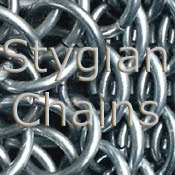"Oh no! Math? You didn't say anything about math!"
It's cool, really. The first number you need is the inner diameter, called ID for short. This is the same dimension as your mandrel, or very close to, depending on how much your metal springs back when winding. To use a recent pair of maille earrings I made as an example. The rings are 4mm ID. This is pretty close to 5/32".
The second number you need is the wire diameter, in this example it's .8mm. or 20ga. or .032" So now you probably understand why I use metric.... Divide the ID by the wire diameter.
4/.8=5 So the Aspect ratio on these rings is 5.

Great right? Right? Oh, yeah, you probably want to know what it's good for.
Everything! Certain weaves like Jens Pind Linkage will only work properly with rings in the right AR. 2.8 to 3.2 or so in that case. When making a nice solid looking European 4 in 1 I find around a 3.5 to work nicely for jewellry. But you can make the same weave with a much larger AR. If you were following up through yesterday's post: "Weaving Chainmail" you may have noticed how some of the rings on the end of a strip seem to magically end up leaning the wrong way. More than likely you didn't make a mistake, just that your AR was loose enough to allow the rings on the end to flip around one another. It's really okay if that happens, they can be prodded back into place.
A chain shirt however, might require a little bit more room to allow for breathing, movement, and simply putting the thing on. A little goes a long way when speaking in AR terms though, so I'd keep it very close to 4.
Note that being able to make a certain chainmail weave isn't the only use for AR. If you want to enlarge or reduce something. Say you saw a pair of earrings and thought, "that weave would look good as a necklace." Most maillers will post ring dimensions (stats) when they show off an item to other maillers. So you can pick out the AR, and choose a larger diameter wire, and an appropriately larger mandrel.
The Ring Lord hosts a very complete Ring Size Chart with AR listings, and sizes in fractional and decimal inches, as well as metric. This is one of my homepage tabs, and I recommend everyone at least bookmark it if you're serious about making maille.
The final, and most amusing characteristic of AR, is it gives us one more abbreviation to use with other maillers while in public, and confuse the non-initiated to no end.
Have fun
--Charon










